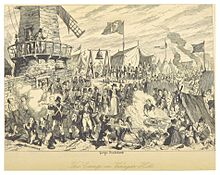Vinegar Hill Windmill
| Vinegar Hill Windmill | |
|---|---|
 | |
 | |
| Origin | |
| Mill name | Vinegar Hill Windmill or Templeshannon Windmill |
| Coordinates | 52°30′05″N 6°33′12″W / 52.50147°N 6.5532°W |
| Year built | 1600–1798 |
| Information | |
| Purpose | Corn mill |
| Type | Tower mill |
| Storeys | Three storey tower |
| No. of sails | Four |
| Type of sails | Common sails |
| Other information | |
| Official name | Vinegar Hill |
| Reference no. | 392[1] |
Vinegar Hill Windmill or Templeshannon Windmill is a tower mill on Vinegar Hill, Enniscorthy, County Wexford.
History

Vinegar Hill Windmill is a small-scale circular single-bay, single-stage windmill, dating from between 1600 and 1798. It sits on a piece of elevated ground, and is of a brick and dressed stone construction.[2]
The windmill was the command centre for the Irish rebel camp during the 1798 Rebellion on Vinegar Hill, and they flew their banner from the windmill. When the rebels were defeated by General Gerald Lake on 21 June 1798, the banner was replaced with the English Royal Standard.[2][3]
Current use
It has been in ruins since before 1840,[2] and most likely fell into disuse after the 1798 Rebellion. The windmill is currently an Irish National Monument (number 392),[4] and was one of a number of post-1700 structures the Irish government considered de-listing from this status in 2011.[5]
When the windmill fell into disrepair in the 1960s, a protest notice was affixed to it stating: "Vinegar Hill, scene of glorious battle in 1798 between Insurgents and British Crown Forces. Carefully maintained by British Government from 1803 to 1922. Abandoned by the Irish Office of Public Works when freedom obtained. Only historic monument in the care of Irish Government in Enniscorthy area. Thank God for it."[6]
The windmill currently forms part of the larger National 1798 Rebellion Centre site, as part of the 1798 battlefield.[7]
References
- ^ "National Monuments of County Wexford in State Care" (PDF). heritageireland.ie. National Monument Service. p. 2. Retrieved 23 November 2022.
- ^ a b c "Templeshannon Windmill or Vinegar Hill Windmill, Vinegar Hill, Enniscorthy, County Wexford". National Inventory of Architectural Heritage. Retrieved 10 June 2015.
- ^ "Vinegar Hill". Look Around Ireland. Retrieved 10 June 2015.
- ^ "National Monuments of County Wexford in State Care" (PDF). heritageireland.ie. National Monument Service. p. 2. Retrieved 23 November 2022.
- ^ "Proposal to de-list archaeological and historical sites that post-date 1700". Irish Archaeology. Retrieved 10 June 2015.
- ^ "Concern for future of Vinegar Hill windmill". Wexford People. November 1967. Retrieved 10 June 2015.
- ^ Medcalf, David (25 October 2011). "The 1.2M plan for Vinegar Hill". Enniscorthy Guardian. Retrieved 10 June 2015.
